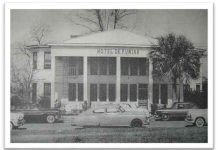Lucha contra la trata de personas: enfermeras de Pensacola y médicos aprenden a detectar signos de abuso
KEVIN ROBINSON | PENSACOLA NEWS JOURNAL6: 29 p.m. CST 29 de noviembre de 2018
El promedio demográfico de una persona que ingresa por primera vez en la prostitución en los Estados Unidos es una mujer, de 13 a 15 años de edad.
Cuando Brad Dennis da esta estadística, siempre es muy deliberado al decir que estas niñas son prostituidas, no prostitutas.
“La prostitución constituye una opción,” dijo Dennis. “Prostituido significa que la elección es eliminada.”
Un estimado de 1.2 millones de niños son traficados en los EE. UU. Cada año, y la Florida es el tercer destino de tráfico en el país, según el Departamento de Salud de la Florida.
Como director nacional de búsqueda para el centro de búsqueda de niños desaparecidos y traficados de la fundación KlaasKIDS, Dennis tiene más de 28 años de experiencia en el campo de búsqueda y rescate, y ha dirigido los esfuerzos de búsqueda de más de 300 niños desaparecidos o secuestrados en los EE. UU.
El jueves, el 29 de noviembre, por la mañana, hizo una presentación a los trabajadores de Baptist Health Care sobre el reconocimiento de los signos de trata de personas y explotación sexual comercial.
Dennis dijo que las salas de emergencia, las clínicas y los hospitales se encuentran entre los pocos lugares donde las víctimas de la trata de personas saldrán a la superficie públicamente mientras aún están bajo el control de su traficante. Los pocos minutos en que una enfermera puede interactuar con una víctima alejada de su traficante, y hacerles preguntas u observar sus lesiones y su comportamiento, son las pocas oportunidades que tienen las buenas personas para intervenir.
“Es importante poder detectar las señales, ya que no se autoidentificarán,” le dijo Dennis al grupo.
Dennis dijo que la única familiaridad de la mayoría de las personas con la trata de personas proviene de las películas y la televisión, donde ven imágenes dramáticas de personas detenidas contra su voluntad en cadenas o cinta adhesiva.
“He sacado a los niños de las perreras, los he cortado de las camas donde estaban amarrados, pero la mayoría de ellos no se ven así,” explicó Dennis. “Se parecen a ti y a mí.”
En una presentación de 90 minutos, Dennis mostró fotos de algunos de los niños que habían sido explotados, algunos que habían sido recuperados, algunos que habían sido identificados y desaparecieron de nuevo en “la vida” y otros que no habían sobrevivido hasta la edad adulta.
La mayoría parecían niños ordinarios, en los que nunca pensarías dos veces a menos que vieras los moretones y las quemaduras de cigarrillos debajo de su ropa. O las “marcas,” tatuajes como “la niña de papá” en el cuello y el pecho, que las identificaron como propiedad de otra persona.
Dijo que no importa cuán mal sean tratadas estas víctimas de trata, casi nunca buscarán ayuda externa debido al “vínculo de trauma” entre ellas y su traficante.
Dennis dijo que los traficantes típicamente “preparan” a sus víctimas a través de severos abusos emocionales, físicos y sexuales. Dijo que la mayoría de las víctimas no solo temen abandonar a su abusador, sino que también están llenas de sentimientos inmovilizadores de vergüenza, culpa y falta de esperanza.
“Los niños son golpeados todos los días, son violados cada noche y nunca abandonarán a su depredador,” dijo Dennis.
Dennis enfatizó que la trata de personas no es solo un problema de la gran ciudad, y que estaba sucediendo aquí en Pensacola, al igual que en South Beach. Señaló que 2,200 niños ingresan al comercio sexual todos los días, muchos de ellos fugitivos u otros jóvenes con problemas, pero no siempre.
La mayoría de las personas de mediana edad escucharon historias de precaución de sus padres sobre el extraño en la “furgoneta blanca” que conducía por los vecindarios secuestrando niños.
Sosteniendo un teléfono celular, Dennis notó que las redes sociales son la “furgoneta blanca” de esta generación.
“La cantidad de información (que los niños) están distribuyendo produce mucha más información y mucha más información con la que el depredador puede trabajar,” dijo Dennis. “Me hace mucho más fácil comenzar a arreglar a alguien si ya conozco todo sobre ellos, y sé todo sobre ellos porque sus vidas están abiertas para mostrarme en Snapchat, en Facebook y en Instagram.”
Las redes sociales les brindan a los posibles traficantes una ventana para observar los intereses de los niños, sus inseguridades, sus vidas familiares, sus horarios. Los traficantes tienen una habilidad especial para identificar a los niños vulnerables y descubrir qué los atraerá.
Pueden querer compañía, pertenencia, atención, afecto, drogas, sexo, cualquier cosa y todo lo demás.
“Una vez que me dices lo que necesitas y empiezo a darte eso, te tengo. Y punto,” dijo Dennis.
Dijo que el reclutamiento ocurre en todas partes, y algunos de los arrestados en todo el país por tráfico de personas incluyen un entrenador de fútbol de la escuela secundaria, un pastor e incluso un detective de homicidios.
Aún así, “Estas personas pueden ser derrotadas. Pueden ser derrotadas por enfermeras realmente increíbles,” dijo Dennis.
Dennis instó a todos a estar más atentos, no a aislarse y no a tomar la decisión fácil de ignorar las pequeñas banderas rojas que te dicen que algo está mal.
“Si eres honesto, probablemente puedas sentarte y mirar algunas de esas indicaciones y decir, ‘Recuerdo un caso’ (donde podría haber hecho más),” dijo.
Dennis instó a cualquier persona que sospeche que puede haber visto signos de tráfico o abuso que llame a la línea directa del Centro Nacional de Recursos contra la Trata de Personas al 888-373-7888, o a la línea directa de Florida Child Abuse al 800-962-2873.
Fighting human trafficking: Pensacola nurses, doctors learn to spot signs of abuse
KEVIN ROBINSON | PENSACOLA NEWS JOURNAL6:29 p.m. CST Nov. 29, 2018
 The average demographic of a person first entering into prostitution in the U.S. is female, aged 13-15.
The average demographic of a person first entering into prostitution in the U.S. is female, aged 13-15.
When Brad Dennis gives this statistic, he is always very deliberate in saying these children are prostituted, not prostitutes.
“Prostitute constitutes a choice,” Dennis said. “Prostituted means that choice is taken away.”
An estimated 1.2 million children are trafficked in the U.S. every year, and Florida is the No. 3 trafficking destination in the country, according to the Florida Department of Health.
As national search director for the KlaasKIDS Foundation’s Search Center for Missing and Trafficked Children, Dennis has more than 28 years of experience in the search and rescue field, and he has managed search efforts for more than 300 missing or abducted children in the U.S.
On Thursday morning of November 29, he gave a presentation to Baptist Health Care workers about recognizing the signs of human trafficking and commercial sex exploitation.
Dennis said emergency rooms, clinics and hospitals are among the few places where human trafficking victims will surface publicly while still under the control of their trafficker. Those few minutes when a nurse can interact with a victim away from their trafficker — and ask them questions, or observe their injuries and their behavior — are the rare opportunities that good people have to intervene.
“It’s important to be able to spot the signs, because they are not going to self-identify to you,” Dennis told the group.
Dennis said most people’s only familiarity with human trafficking comes through movies and television, where they see dramatic images of people being held against their will in chains or duct tape.
“I have pulled kids out of dog kennels, cut them off of beds where they were tied up, but the majority of them don’t look like that,” Dennis explained. “They look like you and me.”
In a 90-minute presentation, Dennis showed photos of some of the children who had been exploited — some who had been recovered, some who had been identified and disappeared back into “the life” and some who hadn’t survived into adulthood.
Most looked like ordinary kids, who you would never think about twice unless you saw the bruises and cigarette burns under their clothes. Or the “brands” — tattoos like “daddy’s girl” on their necks and chests — that identified them as someone else’s property.
He said no matter how badly these trafficking victims are treated, they will almost never go looking for outside help because of the “trauma bond” between them and their trafficker.
Dennis said traffickers typically “groom” their victims through severe emotional, physical and sexual abuse. He said most victims are not only afraid to leave their abuser, but they are also full of immobilizing feelings of shame, self-blame and hopelessness.
“Kids get beaten every single day, they get raped every single night and they will still never leave their predator,” Dennis said.
Dennis stressed that human trafficking isn’t just a big city issue, and it was happening right here in Pensacola, just like it is in South Beach. He noted that 2,200 children enter the sex trade every day — many of them runaways or other troubled youth, but not always.
Most middle-aged folks heard cautionary tales from their parents about the stranger in the “white van” who drove around neighborhoods abducting children.
Holding up a cellphone, Dennis noted that social media is this generation’s “white van.”
“The amount of information (children) are putting out there produces so much more data and so much more information for the predator to work with,” Dennis said. “It makes it a whole lot easier for me to begin to groom someone if I already know all about them, and I know all about them because their lives are on open to display to me on Snapchat and on Facebook and on Instagram.”
Social media gives potential traffickers a window to peer into a child’s interests, their insecurities, their family lives, their schedules. Traffickers have a knack for identifying children who are vulnerable and figuring out what will entice them.
They could be wanting for company, for belonging, for attention, for affection, for drugs, for sex, for anything and everything else.
“Once you tell me what you need and I begin to give that to you, I have you. Period,” Dennis said.
He said recruitment happens everywhere, and some of those arrested throughout the country for human trafficking include a high school football coach, a pastor and even a homicide detective.
Still, “These people can be defeated. They can be defeated by really awesome nurses,” Dennis said.
Dennis urged everyone to be more attentive, not to silo themselves off and not to make the easy choice of ignoring the little red flags that tell you something is wrong.
“If you’re honest, you can probably sit back and look at some of those indications and say, ‘I remember a case’ (where I could have done more)” he said.
Dennis urged anyone who suspects they may have seen signs of trafficking or abuse to call the National Human Trafficking Resource Center hotline at 888-373-7888, or the Florida Child Abuse hotline at 800-962-2873.

















